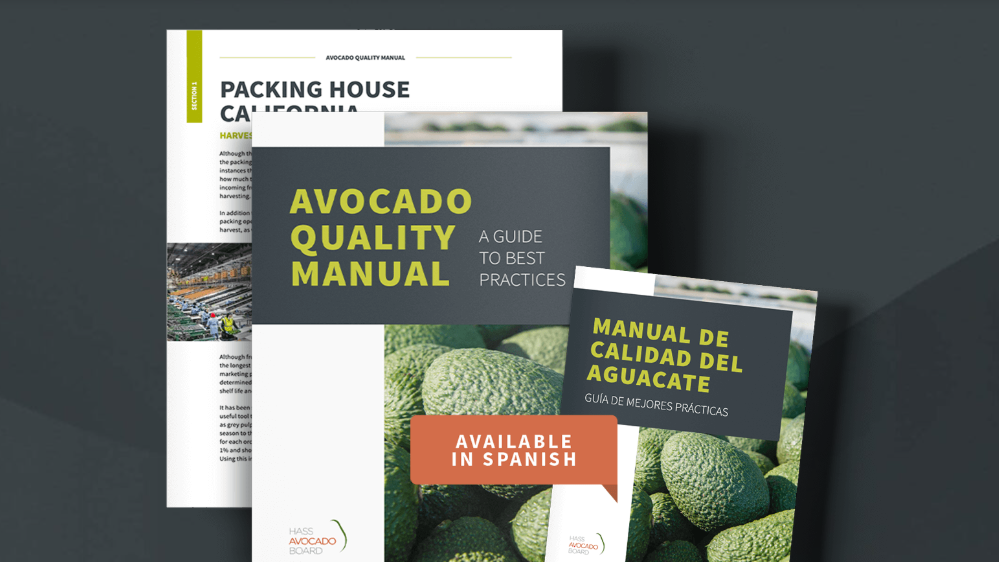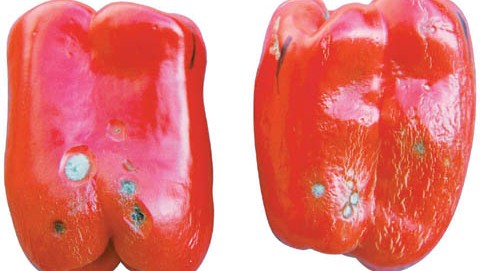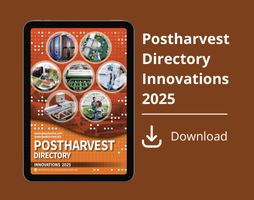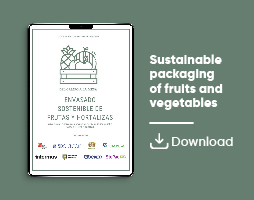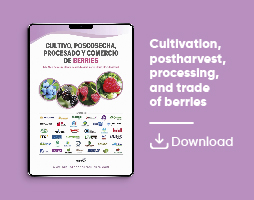Actualidad
Review about how to avoid mycotoxins in pistachio
Iran researchers review efficient solutions to reduce the spread of aflatoxins in both pre and post-harvest stages in pistachio
A stable supply of agricultural products and food safety are among the most important national strategic priorities. Pistachios make a significant contribution to the export of agricultural products in Iran.
However, contamination by Aspergillus species and mycotoxins hinders pistachio production, consumption, and export. Making policies and decisions regarding new technologies to control aflatoxins (AFs) production is crucial.
Good agricultural practices can reduce sensitivity to AFs by strengthening the defense system and reducing stress. Orchard management strategies, physical isolation and moisture control, thermal and nonthermal treatment, essential oils and edible coating have been employed to control fungi and inhibit AFs production.
Currently, biological control is considered an eco-friendly and safe method. This review offers efficient solutions to reduce the spread of AFs in both pre and post-harvest stages.
Introduction
Pistachios are native to the Middle East, with wild pistachio forests still in dry regions of northeastern Iran, southern Turkmenistan, and Afghanistan (Khezri et al., 2020). Currently, Iran and the United States are the world's top two producing and exporting countries (Iran Pistachio Association, 2016; FAOSTAT, 2020). The global tree nuts market was valued at $88.8 billion in 2020, projected to reach $103 billion by 2027 (Chen and Pan, 2022).
Aflataoxin regulations
Pistachio nuts are among the commodities most at risk for AFs contamination (Dini et al., 2022). Developed countries tend to have stricter standards for AFs in the pistachio market, while less developed countries often have more lenient regulations.
However, the European Commission Regulation No. 2023/915 has established a maximum level of 4 mg/kg for the sum of AFB1, AFB2, AFG1, and AFG2, and 2 mg/kg for AFB1 alone in nuts (European Commission, 2023).
The Codex Alimentarius sets a level of 15 μg of total aflatoxin/kg for pistachios meant for further processing and 10 μg total aflatoxin/kg for ready-to-eat pistachios (Codex Alimentarius, 2022).
In Iran, the average total aflatoxin and AFB1 concentration in pistachios was 31.42 and 39.44 μg/kg, respectively (Ebrahimi et al., 2022).
Aflatoxins
Therefore, control measures are necessary to prevent AFs contamination throughout the production, storage, transportation, and marketing chain.
AF-producing fungi are complex communities composed of diverse species and genotypes (Cotty et al., 2008).
The toxigenicity of Aspergillus foodborne pathogens belongs to the Flavi section in several agricultural products. Aspergillus flavus and A. parasiticus are the most toxigenic strains of AFs (Perrone and Gallo, 2017; Kumar et al., 2021). A. flavus is the most common AF-producing fungus (Frisvad et al., 2019). AFs B1, B2, G1, G2 have been identified in pistachios (Aydin and Ulvi, 2019; Abdallah et al., 2020).
One of the main problems with mycotoxins produced by filamentous fungi such as Aspergillus is their high stability and heat resistance, with a melting point above 250 °C and wide pH range tolerance.
Additionally, mycotoxins have undetectable sensory characteristics and do not change organoleptic properties (Winter and Pereg, 2019; Babaee et al., 2022). Therefore, mycotoxin contamination poses a threat to the global economy and food security.
Factors influencing aflatoxin contamination
AF contamination is influenced by various factors, including variety, agroecology, pre-harvest, and post-harvest conditions (Mutegi et al., 2009).
The distribution and abundance of Aspergillus species/genotypes vary depending on the region and type of crop, and the potential for AF production differs among areas (Cotty et al., 2008).
Therefore, AFs contamination may depend on how fungi interact in a particular agroecosystem (Singh and Cotty, 2019). It appears that crop-related genotypes with high AFs production potential play a significant role in AFs contamination and are important etiological factors.
Genotypically and phenotypically diverse species infect plants, but temporal and spatial variations in the abundance of different genotypes suggest that environmental factors may influence the structure of AFs-producing fungal communities.
Additionally, most species in the A. flavus section produce sclerotia. The morphology (small sclerotia or S-type and large sclerotia or L-type) and differences in the types and amounts of AFs produced indicate that genotypes can adapt to different conditions.
It has been shown that the competitive ability and AFs production of AFs-producing fungal species that differ in sclerotial morphology are influenced by temperature.
Influence of the temperature
Competition experiments between highly aflatoxigenic S-type species, such as A. aflatoxiformans and Lethal Aflatoxicosis, and L-type species, such as A. flavus and A. parasiticus, at 25 and 30 °C revealed that at 30 °C, S-type isolates were more effective in colonizing the host compared to L-type isolates.
Total AFs and the ratio of AFs B to G were higher at 30 °C compared to 25 °C. Sporulation by L-type isolates was reduced during competition with S-type fungi at 30 °C, while conidia produced by S-type strains increased or remained unchanged during competition.
It has been confirmed that species interactions and temperature can determine the population structure of Aspergillus section flavi, and warmer temperatures promote the growth and spread of species with S-type sclerotia (Ching'anda et al., 2021). In general, temperature affects both the structure of fungal communities associated with a crop and the amount and type of AFs produced.
The ability of a pathogen to effectively colonize a host is crucial for its growth and reproduction. Research has shown that highly competitive A. flavus species have the greatest impact on AFs content in host tissues (Mehl and Cotty, 2010). S-type strains were found to be more competitive than L-type A. flavus and A. parasiticus at 30 °C, indicating greater access to essential nutrient resources for growth and reproduction at higher temperatures.
Additionally, the development of fungal mycelium contributes to AFs production in the crop (Ching'anda et al., 2021).
Aspergillus flavus S-type strains cause main contamination
It has been observed that S-type strains are the main cause of AFs contamination, even though they make up a small fraction of the fungal community associated with the crop (Atehnkeng et al., 2008).
Therefore, these strains not only have high AFs production potential, but their increased competitive ability during colonization at high temperatures may contribute to the dominance of S-type strains in the crop-contaminating fungal community.
Pre- and postharvest factors contributing to the growth of Aspergillus species
Several pre- and post-harvest factors contribute to the growth of Aspergillus species and contamination with AFs in the food chain.
Environmental factors that affect the distribution and growth of Aspergillus species include geographical regions, soil characteristics, altitude, topography, weather conditions (temperature, humidity, and rainfall), heat stress, and damage from insects and rodents (Zhang et al., 2017).
Internal factors include genotype, nutrient composition, pH, temperature, and water activity (Mannaa and Kim, 2017). While these factors impact the severity of contamination, the presence of two or more factors may be enough to support fungal growth and AFs toxicity (Lahouar et al., 2016; Gonçalves et al., 2019).
Aspergillus flavus is the main aflatoxin producer
The most important species producing AFs is A. flavus (Kumar et al., 2021).
The mycelium is the primary structure of the fungus in the soil, and its long-term survival is achieved through the production of sclerotia. Physicochemical conditions such as nutrients, water availability, temperature, and pH control the growth of fungi and sclerotia (Nelson, 1993).
As a saprophytic pathogen, Aspergillus flavus can utilize a wide range of organic nutrients (Amaike and Keller, 2011; Thathana et al., 2017). Sporulation is observed in nutrient-rich environments, especially in substrates with high nitrate content (Mehl and Cotty, 2013).
Aspergillus flavus grows in the pH range of 1.2–11.2, with the optimal pH for its growth between 3.5 and 8 (Wheeler et al., 1991).
The optimal growth temperature is 28–37 °C and 0.90–0.99 water activity, but the fungi can survive at temperatures between 12 and 48 °C and 0.77 water activity (Thathana et al., 2017). Optimal temperatures in subtropical or warm temperate regions are available for an extended period, allowing the persistence of Aspergillus species (Klich, 2002).
However, fungi are not limited to specific geographical or climatic regions. Therefore, growth and toxin production are possible under favorable environmental conditions (Papp et al., 2002).
Environmental factors explain the spatial and temporal variations in contamination
Jaime-Garcia and Cotty (2003) observed the effects of spatial and temporal variations in AFs contamination, which were mainly influenced by environmental factors. Ecological changes, global precipitation variations, and changes in cropping patterns may alter the distribution and population composition of Aspergillus. These changes are influenced by soil temperature and moisture (Jaime-Garcia and Cotty, 2003).
In tropical or subtropical regions where the annual temperature changes from 20 to 30 °C and there is high annual rainfall, conditions are ideal for the growth of Aspergillus and the accumulation of AFs ( 2019 Frederick and Leinbach).
Pistachios with damaged shells show higher contamination
Environmental factors, such as heat and drought stress, can cause the pistachio shells to split during growth. Shell damage may also result from improper harvesting methods, insect stings, and inadequate nutrient intake. Previous studies have indicated that AFs contamination is higher in nuts with damaged shells compared to those with healthy shells (Lahouar et al., 2016; Achaglinkame et al., 2017).
AFs biosynthesis is influenced by various environmental conditions, including light, temperature, humidity, concentrations of oxygen and carbon dioxide, acidity, carbon and nitrogen sources, and metals (Mahbobinejhad et al., 2019).
Light
Light plays a role in regulating the expression of AF biosynthetic genes and the formation of resistant structures such as sclerotia, as well as fungal growth. Conversely, darkness increases AF production (Fanelli et al., 2016; Rushing and Selim, 2019).
Gas control
AF production is inhibited at higher levels of CO2 and lower levels of O2 (Mahbobinejhad et al., 2019). Acidic conditions are more suitable for AF production, and the transcription of AF biosynthetic genes is downregulated in alkaline conditions compared to acidic conditions (Yu et al., 2024).
As biological agents, the carbon sources for AF synthesis are glucose, sucrose, fructose, sorbitol, ribose, xylose, and glycerol (Liu et al., 2016), while nitrogen sources such as asparagine, ammonium salts, and glutamate stimulate AF production (Gizachew et al., 2019).
Metals
Additionally, metals, especially zinc and manganese, are essential factors for AF production (Liu et al., 2016). A combination of copper, iron, and zinc has been shown to increase AF biosynthesis, while a combination of cadmium and iron reduces Aspergillus growth and AF production (Gilbert and Anklam, 2002).
Temperature and water activity
Studies have also shown that temperature and water activity are two important parameters in the production of AF. The optimal temperature for AF production is 28–30 °C, with production decreasing at temperatures above 37 °C (the optimal temperature for fungal growth). A decrease in AF production has also been observed at temperatures below 18 °C. The optimal AF production occurs at 0.95 water activity ( Yu et al., 2011; Taghizadeh et al., 2018; Gizachew et al., 2019; Tai et al., 2020).
Soil
The type of soil and the shape of the land affect the growth of fungi through the maintenance of soil moisture. Soil with high clay content and low sand provides conditions for AF contamination, and the population of Aspergillus was significantly correlated to the clay content (Jaime-Garcia and Cotty, 2004).
Soil organic matter is one of the main characteristics of soil and affects the Aspergillus population (Abbas et al., 2009). Soils containing high organic matter have a higher water-holding capacity, which provides optimal conditions for the growth and survival of fungi. Therefore, the population density of Aspergillus was higher in soils with high content of organic matter, potassium (K), nitrate (NO3−), and phosphate (PO4−), EC, and pH (Zablotowicz et al., 2007).
Surface soil temperature
The temperature of the soil surface is another important factor affecting the fungal population, and when the average soil temperature is between 18 and 30 °C, fungal reproduction increases (Jaime-Garcia and Cotty, 2010).
Analysis of soil moisture and temperature has shown a significant relationship between drought stress and the spread of A. flavus (Rees et al., 2017). Additionally, infected plant residues in soil act as the source of Aspergillus (Yang et al., 2017), and providing sufficient moisture in autumn plays a role in the spread of fungal spores (Moradi et al., 2004). A. flavus spores can be spread through direct contact with soil, dust particles, or insect vectors (Abbas et al., 2009).
Agricultural practices
Research on the ecology of Aspergillus species has shown that the population of Aspergillus species in pistachio orchards is influenced by horticultural and agronomic operations.
These include pistachios thrown on the ground, male pistachio inflorescences, plant residues, organic matter, animal manures, irrigation regime, the time interval between two successive irrigations, the relative humidity of the environment and the fruit, damage by pests and birds, and determining the optimum harvest time (Giorni et al., 2008; Moradi et al., 2014).
The splitting of green shells effectively causes the spread of Aspergillus fungi and AFs production (Moradi et al., 2014). Several factors affect the early splits of pistachio nuts (hull and shell), including irrigation systems, nutrition, root system type, variety, age, crop quantity, soil physicochemical characteristics, and diurnal temperature variation (Moradi et al., 2014).
Due to the complexity of factors affecting AFs contamination, the application of separate technologies may not offer full protection.
It is necessary to integrate aflatoxin management
Therefore, it is necessary to integrate AFs management throughout the entire supply chain (Logrieco et al., 2018). Controlling AFs contamination is possible through two general strategies, including proper pre- and post-harvest management (Lavkor and Var, 2017) (Fig. 1). This review aims to provide and highlight efficient solutions to reduce the spread of AFs in pistachios at pre- and post-harvest stages.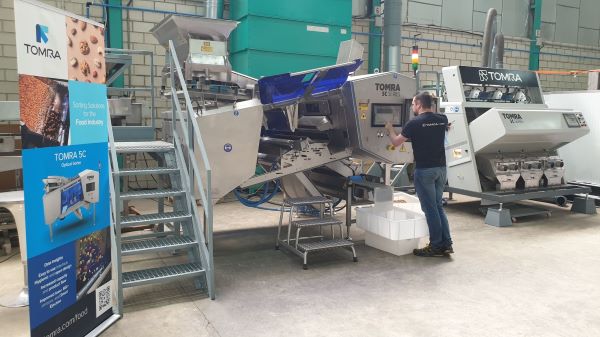
Tomra counts on equipment to detect aflatoxins
Sources
Aflatoxins control during pre and postharvest stages in commercial pistachio production
Azam Ranjbar, Amir Hossein Mohammadi, Farid Moradinezhad
Journal of Stored Products Research Volume 111, May 2025, 102563
https://doi.org/10.1016/j.jspr.2025.102563
https://www.sciencedirect.com/science/article/abs/pii/S0022474X25000220
Picture
Main picture - Los efectos en los riñones de comer pistachos a diario
https://www.heraldo.es/noticias/salud/2024/12/26/comer-pistachos-diario-efectos-rinones-salud-1712834.html
Tomra picture - Cómo los procesadores de frutos secos pueden beneficiarse de las últimas tecnologías de clasificación, https://www.poscosecha.com/tomra-food/como-los-procesadores-de-frutos-secos-pueden-beneficiarse-de-las-ultimas-tecnologias-de-clasificacion


